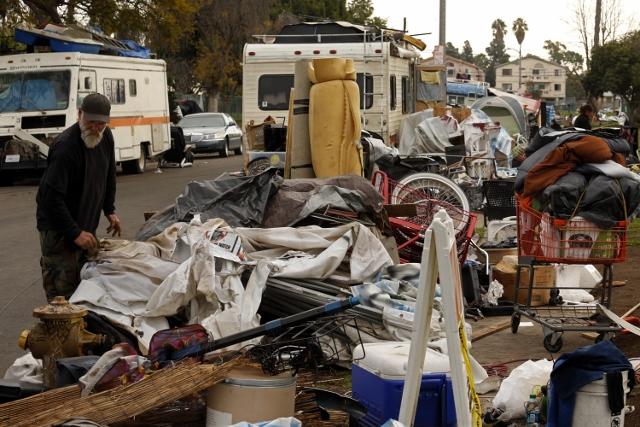Homelessness in a ghost town
Armon Coleman, 63, looks over his belongings, left, at his homeless encampment along W. 94th Street in the Manchester Square neighborhood on Jan. 4, 2017 in Los Angeles. LAX has bought much of the property from homeowners over the past years and will eventually build a rental car facility at the site. In the meantime, the homeless are sleeping on sidewalks outside the fenced lots that are owned by LAX. (Genaro Molina/Los Angeles Times/TNS)
February 16, 2017
LOS ANGELES — When Bill Clinton was president, the operator of Los Angeles International Airport began buying up and razing Manchester Square, a cozy 1950s housing tract located under the flight path.
The buyouts took care of the residents’ noise complaints but left behind an eerily suburban ghost town of lush green lawns, sans houses.
LAX is finally preparing to develop a rental car facility, parking areas and a transportation hub in the 20 square blocks of Manchester Square as part of its modernization plan.
But as homelessness rose during the last three years, and parking crackdowns drove campers and RVs out of nearby Venice and other communities, the neighborhood became filled with one of Los Angeles’ largest collections of homeless camps outside the 50 square blocks of skid row.
The squatters’ village of tents, peeling campers, lopsided RVs and cars is home to 200 to 350 people. The airport, which has spent $437 million buying out residents and plans to spend an additional $1 billion for property, won’t pay to relocate the homeless occupants.
Mary Grady, a spokeswoman for Los Angeles World Airports, said airport revenue can be spent only on aviation-related facilities at LAX, such as passenger terminals, runways and taxiways.
Airport officials have said construction preparation for several new projects in Manchester Square could start as soon as January 2018, although no deadline has been set.
To help the homeless people move on, the city and county of Los Angeles set up a multi-agency task force a year ago.
But with the clock running down, only six people have found permanent housing, and others say they have nowhere to go.
“This is the new homeless,” said Sherri Kelly, 54, who shares a camper at the square with her husband. “Once you’re out here, it’s nearly impossible to come in. There’s no place else to park or that we can run to.”
Officials said they are confident they can relocate the squatters before the airport project, which is in environmental review, begins. The task force includes specially trained airport police officers, city street services and sanitation departments, and mental health and outreach teams.
“No entity can be singularly responsible for tackling the homelessness crisis. If we are going to lift up homeless Angelenos and help them find safe places to sleep, we need an all-hands-on-deck approach,” Mayor Eric Garcetti’s press secretary, George Kivork, said in an email.
Some in Westchester fear the effort will trigger a mass expulsion from Manchester Square.
“I don’t want them to start forcing these people out. Where are they going to go?” said Garrett Smith, a director on the Neighborhood Council of Westchester/Playa.
How this nest of postwar domesticity became a textbook case of urban blight is a story of politicians’ shifting visions and legal and economic setbacks.
Manchester Square sprang up after World War II to house aerospace workers, teachers and pilots. As noise complaints grew, the airport decided on a voluntary buyout plan, but home purchases fell off after the 9/11 terrorist attacks and again during the Great Recession.
For years, no proposals to reuse the property were finalized. Under Mayor Richard Riordan, a cargo facility was floated, and Mayor James Hahn proposed a giant transportation/check-in center, part of an LAX master plan that ended up in court.
Airport officials now plan to use the property for a consolidated car rental facility, additional parking and a public transportation hub. The owners of six houses and 31 apartment buildings are the last holdouts, Grady said.
Some of the squatters who moved in said they lost their homes in nearby communities, including Hawthorne and Redondo Beach, because of various life crises, disabilities and lost jobs.
Carlos Alvarez, dean of the Bright Star Secondary Charter Academy in Manchester Square, said a group also arrived from Venice, where homelessness dropped about 25 percent from 2015 to 2016 after a crackdown on occupied campers.
“We always had motor homes on 99th Street, but two years ago, we came back from summer break and it had just exploded,” Alvarez said.
Renters blame the camps for car break-ins, vandalism and people sleeping in their laundry rooms. Police said most of the crime is petty. Substance abuse and mental illness is “a huge factor,” said Anika Simpson, a nurse with the county mental health evaluation team.
The bare lawns are fenced off, so the homeless people sleep in vehicles or camp out on grassy parkways. Regular city cleanups send them scurrying with mattresses lashed to shopping carts as men in hazmat suits spray the turf with disinfectant.
Alvarez said police escort schoolchildren past the camps. The homeless are largely cooperative, he said. “At 3 p.m., they go inside their tents.”
But some are not as amenable to the task force’s ideas of where they should move.
“I’m not working on housing. Housing is negative equity. It costs money, and if you take the cash allowance and food stamps, that’s not enough,” said a two-year resident who gave his name only as Frank R. “I make that recycling.”
As for shelters, he added, “I’m a drinker and you can’t do that. Where’s my cocktail in the shelter?”
Other homeless people say they live off disability payments or low-wage jobs and can’t afford L.A.’s soaring rents. Kelly, who once lived in a Manchester Square apartment, said she was evicted from her home in Hawthorne after her accounts were frozen in a messy identity theft case.
“I lived a normal life,” she said. “We’re not criminals. We’re middle-class Americans.”








